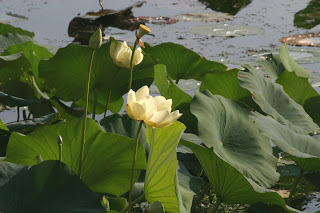Funny things happen to
your water when it doesn’t bubble enough....
Most of us are used to
thinking of ‘bubbling water’ from the carbon dioxide that is in our sodas. You open the can or the bottle and hear
the ‘f-f-f-i-i-i-z-z-z-z-z’ release of the gas coming out of the solution of
water and flavorings. Or people
can make the cork in the champagne bottle go flying and the fizzy wine comes
running out -- it really looks great at weddings.
But we are more interested
in getting a different kind of bubble -- the “ O2 “, or oxygen --
put into the water. That can
actually happen several different ways:
Bullfrog and Duckweed at
August A. Busch Wildlife Area, Weldon Springs, MO (photo: Gay Schroer)
1. All plants, from the mighty trees down
to the simple green algaes, use water, carbon dioxide, and sunlight to make the
sugars they need to grow. This
process, known as photosynthesis, releases oxygen as the byproduct. We animals benefit from all that oxygen
in the air, but few people stop to consider that algae and aquatic plants
release a lot of oxygen
back into the water.
Lotus plants, August A. Busch Wildlife Area, Weldon Spring, MO (photo: Gay Schroer)
2. The temperature of the water and what
level it is at also makes a big difference in the amount of dissolved oxygen
that is available to the wetlands.
Since the “ O2 “ dissolves into water the same way that other
chemicals and salts do, cooler temperatures increase the amount of oxygen that
the water can hold. When the water
gets warmer, more oxygen bubbles out of solution, exactly the same way that
water forms bubbles when you boil water on the stove....the dissolved oxygen is
leaving the solution. The depth of
the water also makes a difference in the amount of oxygen present. During the summer, the top layers of
the water have less oxygen available than the deeper levels of the
wetlands. (Pressure also
plays a factor, but we can save that for a later blog).
Marymere Falls,
Olympic National Forest, Washington state (photo: Gay Schroer)
3. Water movement -- that babbling
brook that is so picturesque -- is also critical to help dissolve more
oxygen. The more the water is
‘diffused’ around, pushed, bent, even thrown up into the air with the help of a
beautiful fountain, all helps bind more oxygen back into the water for the
benefit of a healthy wetlands ecosystem.
A dissolved oxygen
level meter (photo: wikipedia)
4. Dissolved oxygen levels is a
measurement that environmentalists and engineers can test for. Getting the right proportion of
dissolved oxygen back into the water is critical to supporting a balanced
ecosystem. In fact, that is
generally what we call the test -- we measure the “Biological Oxygen Demand” of
the water (our BOD counts). If the
amount of oxygen is too high or too low, the whole system can get out of whack,
causing excessive algae growth, fish kills, and other disasters that we would
rather avoid.
There are other things we
measure in our water samples and that will be covered in upcoming blogs. Wait until you hear about how your poop
gets recycled!
Submitted by Paula
Arbuthnot, World Bird Sanctuary Part Time ETC Employee







No comments:
Post a Comment